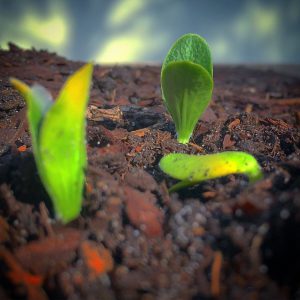 If you live in Hardee County, there are a range of soil types that make our area diverse. Also the former presence of citrus groves, livestock operations and vegetable fields where we now call our homestead can add a little more variety to our soil composition.
If you live in Hardee County, there are a range of soil types that make our area diverse. Also the former presence of citrus groves, livestock operations and vegetable fields where we now call our homestead can add a little more variety to our soil composition.
If you live in a sandy soil area and you still want a thriving vegetable garden crop, you will probably need to add organic matter on a regular basis. Amending our vegetable garden with organic matter brings several benefits.
What is organic matter?
Organic refers to any compound that has carbon as its base. This term is used to label something derived from living matter. In general, organic matter is the remains of plants and animals. The organics you apply to the soil are most often in the form of bird and animal manures, plant (green) manures, cover crops, compost, sea products, and mixed organic fertilizer.
Benefits of Organic Matter
- Improves tilth, condition and structure of soil, providing better aeration and temperatures.
- Supports living soil-organisms.
- Improves ability of soil to hold water and nutrients.
- Buffers soil from chemical imbalances.
- Holds fertilizers and improves the availability of plant nutrients.
- May contribute some degree of biological control of certain soil pests.
- Helps recycle organic wastes, thus keeping them out of landfills and waterways.
Converting livestock and vegetable waste into fertilizer
With suitable conditions, organic matter is broken down by organisms living in the soil, such as fungi, bacteria, algae, molds, insects and earthworms. In the process, nitrogen and other nutrients are converted to forms a plant can use. Nitrification is the term used for the conversion of organic nitrogen to available forms. Since nitrogen is the nutrient most often limiting plant growth, you must make sure that the following conditions exist in your soil (or compost pile) for good nitrification to occur:
- Nitrogen-rich materials
- Proper acidity (pH): 5.8 to 7.0
- Proper temperature—over 50°F
- Good aeration
- Adequate soil moisture.
Animal-Derived Products (Manures and Composted Products)
Bird and animal manures are generally available to home gardeners, either as processed, composted products in bags, or in some raw form. Generally, manures from animals that eat vegetation are preferred to that from meat-eating animals, for sanitary reasons.
Animal manures vary greatly in their content of fertilizing nutrients, depending on type, age, and condition of animal; kind of feed used; age and decomposition of manure; moisture content; and the litter accompanying the manure. Some manure products are composted or mixed with various plant products to achieve a preferred formulation.
Most animal and bird manures in the raw form have an analysis in the range of 0.5 to 4.5% N; 0.2 to 2.0% P; 0.4 to 2.0% K. Since they also contain micro-nutrients, bird and animal manures may be used as the sole fertilizer source in the garden. However, due to their high moisture content (60 to 90%) and relatively narrow carbon to nitrogen ratio, they are less useful for building humus in the soil than are the plant-residual materials. Thus, animal manures have great value as a nutrient source for micro-organisms in compost piles, and when mixed with plant-derived compost for direct soil application. Some of the most common types of animal and bird manures found in Florida are poultry litter (chicken and layer), cow, equine, swine and small ruminant manures.
Green Manures
Green manures are derived from plants, either as ground-up plant products, whole plants, or as cover crops. Green manures have a higher carbon to nitrogen ratio than most animal manures (except manures with a lot of bedding material), and thus are excellent for improving soil structure. Additions of the more woody materials, such as wheat straw, sawdust, wood shavings, and composted yard waste, should be accompanied by addition of more nitrogenous materials, such as animal manures or leguminous crops.
Cover Crops
Plants (crops) seeded, grown, then plowed into the garden soil to provide green manure are called cover crops. By cover cropping, you can provide all of the benefits of adding organic matter, plus help recover/recycle nutrients from past seasons.
By planting a legume as your cover crop, you can actually supply additional nitrogen that will be available to next season crops. Legumes form nodules on their roots; inside the nodules, bacteria convert atmospheric nitrogen to forms of nitrogen that the plant can use.
To be most beneficial to the garden, the cover crop must be plowed down (or added to a compost pile) so that this “captured” nitrogen can be released by the process of nitrification. Allow a few weeks’ time between plow-down and planting in your garden. Early investigations proved that the greatest benefit was achieved when the green manures were incorporated at the half-grown stage. At this stage there is more nitrogen available and fewer problems related to soil-borne diseases.
Chances are that you may have a source of composted manure nearby or have the capacity to plant a cover crop in fallow areas that will be used next year. Also, including a rotation between your chicken coop and your vegetable garden is a great way to utilize nutrients in the soil. With a little work, you can incorporate this into your farm or homestead practice and save some bucks along the way.
If you would like to learn more about vegetable gardening, please visit or call the UF/IFAS Extension Hardee County office or call us at 863-773-2164. We are here to help.
Further reading:
Soils & Fertilizers for Master Gardeners: Soil Organic Matter and Organic Amendments
 0
0
